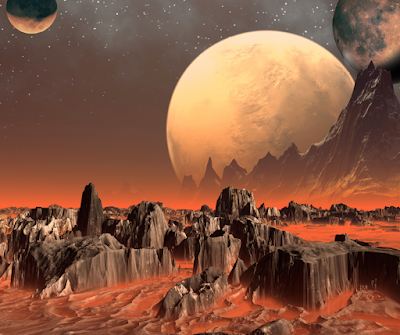Moon Cycles on Sandig Skaa
What is a moon cycle on Sandig Skaa?
This question has come up a few times as Keegan and Tana have both reflected on the timing of different events over the course of moon cycles.
The books (Secrets of the Desert, Into the Den, Sand & Stone) mention several times that a moon cycle is 30 days... but what exactly does that mean?
My editor has convinced me to include a more thorough explanation (though it will still be short) in Into the Den, but if you can't wait (or if you want the super awesome, long explanation) here it is:
Mater Moden is the largest moon. It is also closest to the planet and has the fastest orbit: every 30 days. This is one moon cycle.
The middle-sized moon, Uropa, completes one orbit every time Mater Moden completes six. Every six moon cycles, both Uropa and Mater Moden have a full moon at the same time. (Fun Fact: I named Uropa after Jupiter's moon Europa because I think it's super cool that it is essentially an ocean planet covered with a layer of ice!)
The smallest moon, Bebari, completes one orbit every time Mater Moden completes five. Every five moon cycles, both Bebari and Mater Moden have full moons at the same time.
Uropa and Bebari have a full moon at the same time every 30 moon cycles. Every 60 moon cycles (or once every five years), all three satellites appear in the sky at the same time as a full moon.
Over the course of a year, two of the moons will appear full at the same time on four dates (the fifth month, sixth month, tenth month, and twelfth month). The fifth and tenth months will see Mater Moden and Bebari full at the same time. The sixth and twelfth months will see Mater Moden and Uropa full at the same time. These "Double Full Moon" events are when Heimat Draz hosts their Oath Tests, allowing men to move from New Recruit status to a New Guard.
Every two and a half years (or every 30 moon cycles), the two smaller moons rise full together. These events do not count as a Double Full Moon because the biggest moon is not full, so the sky is not quite as bright. Every five years, when all three moons rise together, a much larger holiday is celebrated: the Triple Full Moons. The Oath Tests are included in the bigger event.
As a fun bit of background, I was inspired by Jupiter's three inner-most moons for some of this science. Those moons are in orbital resonances: every time Ganymede orbits once, Europa orbits twice and Io orbits four times. For curious minds, Ganymede's orbit takes 7.154 Earth days. Callisto (Jupiter's "other" Galilean moon) is not in orbital resonance with the first three, but it's orbit is really close to a 7:3 ratio (every time Ganymede makes 7 orbits, Callisto makes 3 orbits. This takes just over 50 Earth days).
Want to learn more about life on Sandig Skaa? Read the books!
Happy reading!
💖 Anabelle Raven


.png)
.png)
Comments
Post a Comment